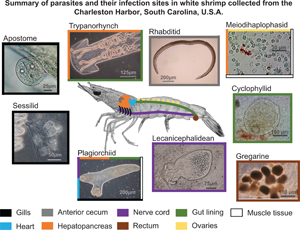Research Article
Morphometric and molecular characterization of an unpigmented haemosporidian parasite in the Neotropical turnip-tailed gecko (Thecadactylus rapicauda)
-
- Published online by Cambridge University Press:
- 21 October 2022, pp. 221-229
-
- Article
-
- You have access
- Open access
- HTML
- Export citation
Ontogenetic and spatial variability in parasite communities of white shrimp Penaeus setiferus (Decapoda: Penaeidae)
-
- Published online by Cambridge University Press:
- 12 December 2022, pp. 230-239
-
- Article
-
- You have access
- Open access
- HTML
- Export citation
A rare case of human taeniasis caused by Taenia saginata with species undetermined cysticercosis
-
- Published online by Cambridge University Press:
- 19 December 2022, pp. 240-247
-
- Article
-
- You have access
- Open access
- HTML
- Export citation
Revisiting fecal metatranscriptomics analyses of macaques with idiopathic chronic diarrhoea with a focus on trichomonad parasites
-
- Published online by Cambridge University Press:
- 12 December 2022, pp. 248-261
-
- Article
-
- You have access
- Open access
- HTML
- Export citation
Bat–parasite interaction networks in urban green areas in northeastern Brazil
-
- Published online by Cambridge University Press:
- 19 December 2022, pp. 262-268
-
- Article
-
- You have access
- Open access
- HTML
- Export citation
Cyclospora cayetanensis comprises at least 3 species that cause human cyclosporiasis
-
- Published online by Cambridge University Press:
- 23 December 2022, pp. 269-285
-
- Article
-
- You have access
- Open access
- HTML
- Export citation
Morphological and molecular characterization of Cosmocercoides amapari n. sp. (Nematoda: Cosmocercidae), parasitic in hylid frogs from the Brazilian Amazon
-
- Published online by Cambridge University Press:
- 17 January 2023, pp. 286-296
-
- Article
-
- You have access
- Open access
- HTML
- Export citation
Epidemiology of protozoan and helminthic parasites in wild passerine birds of Britain and Ireland
-
- Published online by Cambridge University Press:
- 04 January 2023, pp. 297-310
-
- Article
-
- You have access
- Open access
- HTML
- Export citation
e-only frontmatter
PAR volume 150 issue 3 Cover
-
- Published online by Cambridge University Press:
- 13 February 2023, p. f1
-
- Article
-
- You have access
- Open access
- Export citation








